Driving a Lamborghini on public roads is an experience that’s akin to tight-rope walking. People point and exclaim, happy they’re seeing something so rare in action. The brand is built on spectacle and wow-factor.
Legend has it that in the mid-’60s, one of the first Miuras was parked in front of the Hotel de Paris during the Monaco Grand Prix, and caused the square to be completely clogged up by onlookers and oglers. The atmosphere around a Lamborghini is always buzzing.
Inside the car, the driver and passenger are buzzing too. The performance is astounding, as is the certainty of being the center of attention, but it requires so much discipline to try and keep things legal.
With 740 horsepower, the Aventador S is a beast, accelerating to highway speeds in under three seconds and capable of hitting a top speed of 217 miles per hour. It goes without saying, it’s overkill on the road, and with a design as eye-catching this, it can bring some unwanted attention if you dare to explore the limits of this car in a public space. And you don’t want to get this $421,350 car impounded.
See Also: 2017 Lamborghini Aventador S Video and Review
The only place where the Aventador S would fit in then would be the track, but the brand isn’t known for its motorsports heritage. Currently the brand’s smaller model, the Huracan, is being raced in a number of series, but the Aventador has a limited presence in the big racing series out there.

Fortunately, the automaker provided us with a quick track day to show what this big bull can do, without worrying about mundane things like speed limits.
We joined the automaker at Canadian Tire Motorsport Park to put these burly cars through their paces and learn what makes them so capable at speed. It turns out, good things come in fours. Here’s the scoop:
6.5 Liters of Stubborn Goodness
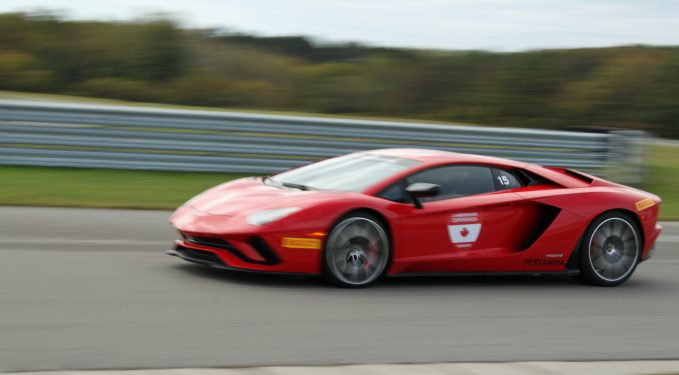
A major part of all this performance is the engine. To be blunt, big naturally aspirated engines with a bajillion cylinders are becoming rare these days. But Lamborghini stubbornly sticks to its guns, offering a twelve-cylinder engine, which is just how the founder wanted it when he set out to make his own exotics back in the early ‘60s. Mounted just behind the driver is this 6.5-liter V12, and it’s a doozy of a powerplant. While smooth, you’re always resisting temptation to contain it at a reasonable speed, but it can really stretch its legs on the track. It sounds otherworldly, and when you fire up the ignition it clears its throat with head-turning volume.
See Also: Lamborghini Saving the day: NA V10s and V12 Will Stay
And every time this rolling piece of Italian art came driving by at full throttle, everyone’s face lit up, causing smiles and dropped jaws all along the pit wall. It was a repeated joy that had everyone at the track giddy. And hey, 12 is a multiple of 4!
Four-Wheel Drive
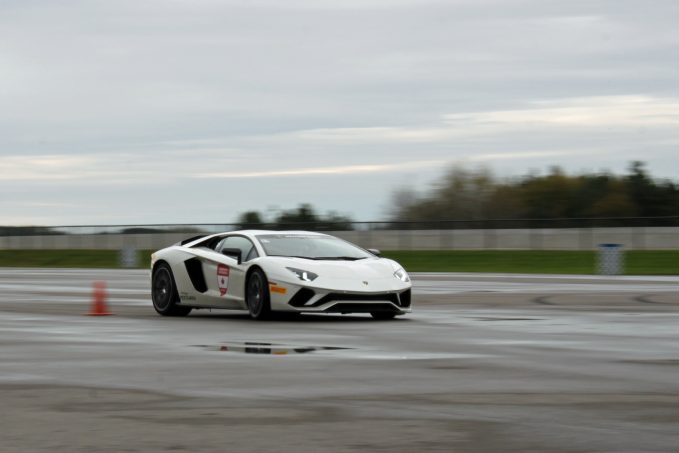
Even having all that power in an open space like the race track can be a handful… if it’s not properly managed. Lamborghini figures this engine can be somewhat domesticated with its all-wheel-drive system.
Power is sent to all four wheels at all times, but the distribution of that power changes based on the driving modes and conditions. Ultimately, there’s an impressive amount of grip, even in the damp and gloomy conditions in which we whipped these things around. On the track, the all-wheel drivetrain lets the car get going after a corner with serious speed and confidence, but another element that deserves credit has to be the specially crafted Pirelli P Zero Tires wrapped around all four wheels.
Four-Wheel Steering
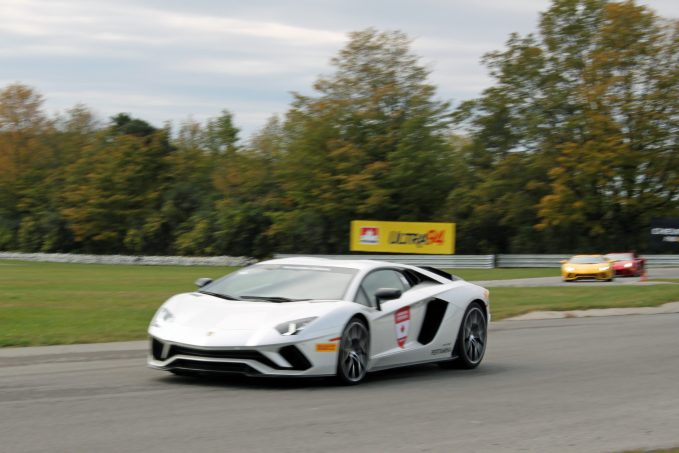
A wide, powerful car, the Aventador S needs much more than all-wheel drive to keep it nimble. A new four-wheel-steering system inherited from the ultra-rare Lamborghini Centenario is now included on the Aventador S. It’s smartly integrated, tying road speed to its operation. At low speeds, the rear wheels turn the opposite way of the front ones, to a maximum articulation of three degrees. At speeds higher than 80 MPH, however, the rear wheels will turn in unison with the front wheels, but only half as much as they do in slower settings.
In simpler terms, it’s like the car can extend or shrink its wheelbase on the go. At lower speeds, the wheelbase essentially shrinks, enabling a tighter turning circle and allowing the car to feel nimble despite its width. At higher speeds, where one can be a bit nervous to make any dramatic adjustment to the steering, the rear wheel steering helps the car feel more planted by practically lengthening the wheelbase. Testing this on the track and on a slalom course, the car felt really natural and easy to pilot, something you wouldn’t expect from a supercar.
Four Big Brakes
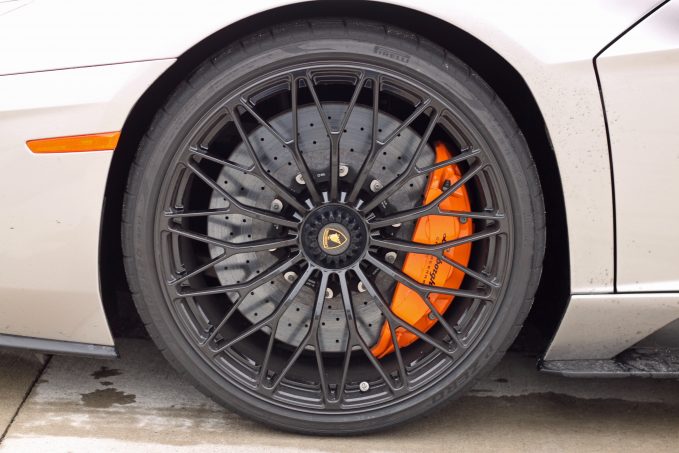
As you get into the rhythm on the track and get comfortable with the capabilities of the Aventador S, you end up picking up some serious speed. But when you need to slow things down the carbon ceramic brakes can bring the car down to a manageable pace with surprising speed.
The car uses six-piston stoppers for the front wheels, while four-piston units handle the rear wheels, which is to say the car has serious stopping power. This is important as you take such an expensive car from steady speeds to mind-altering, blurry-vision-capable speeds in just a few warm-up laps. It’s nice to know the car can return back to normality with a quick stab of the brakes.
Four Drive Modes
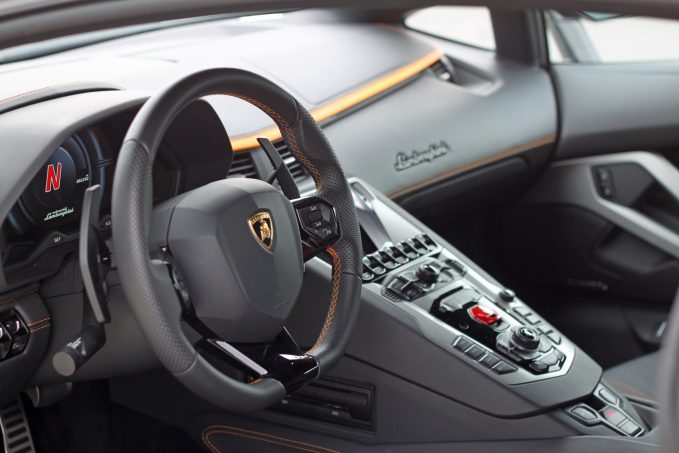
Drive modes can really alter the way the Aventador S is driven. For example, in the “Strada” setting, the car splits the power between the front and rear axles 40/60 respectively, but in the Sports mode, it changes that up 10/90, sending more power rearward. Flipping the switch into the track-focused Corsa mode, it changes that up once more to split things 20/80, bringing some more power up front so the car can claw its way through more apex speed on the closed course.
The drive modes also alter the throttle response, steering, suspension and stability control. With a variable-ratio steering rack and magnetorheological push-rod suspension, the car dynamics can change drastically between the drive modes. But Lamborghini allows drivers to mix and match individual characteristics to suit their driving preferences.
Seven Clunky Gears
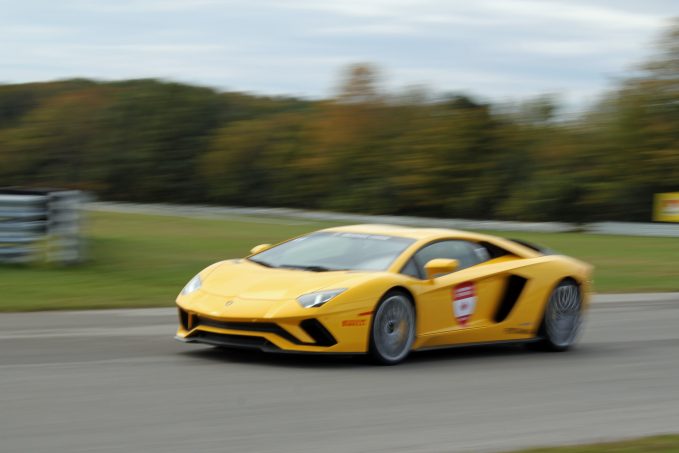
Which is a good thing, because the drivetrain in its street mode is really unnaturally clunky and slow. Using a single-clutch automatic transmission that feels really old-school, the car slaps gears together with a surprising lack of refinement or speed. This is the only thing that doesn’t fall into the Aventador’s philosophy of “good things come in fours” so no wonder it’s a weak spot!
See Also: Should You Buy a Car with a Dual Clutch Transmission?
Changing the drivetrain setting to Sport or Corsa and it picks up the slack, but it’s very interesting that the Aventador S uses this older-feeling transmission when the more affordable Huracan uses a very fast and more refined dual-clutch transmission.
By using the customizable drive mode, you can pair the sportier drivetrain settings with more comfortable chassis settings so the car acts just right.
The Verdict: 2017 Lamborghini Aventador S Track Test
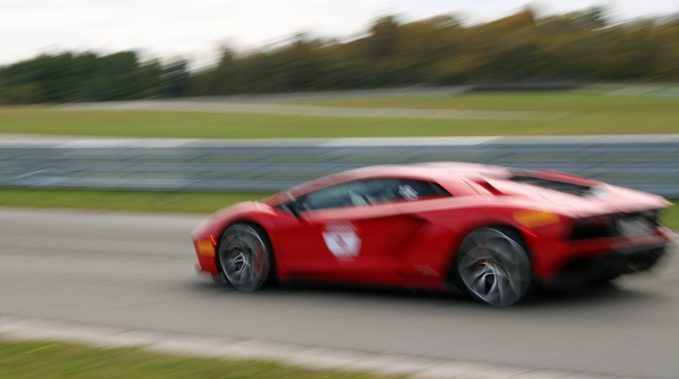
At the end of the track day, there was a newfound appreciation for the supercar. A car that turns heads just when it’s parked, it also proved to be perfectly capable of driving at high speeds and around tight corners, where the sky is the limit, rather than the law. It truly completes the Lamborghini experience.



Leave a Reply